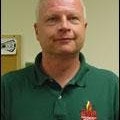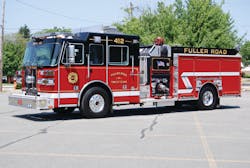The Town of Colonie, NY, is protected by 12 fire departments that operate as separate volunteer organizations and are coordinated through a town emergency services committee. For a number of years, these departments have worked together on numerous initiatives including joint purchasing and training groups. In addition, all areas of the town are covered by a phantom box-alarm system to provide adequate apparatus and staffing resources to each of the fire companies’ first-due areas. The Town of Colonie comprises some 58 squares miles with a population of more than 80,000. The area is adjacent to the state capital of Albany and is home to the Albany County Airport and numerous commercial, industrial and institutional properties.
The Fuller Road Fire Department was organized in October 1926 and protects the southeastern portion of the town. The first-due area is heavily developed with the Colonie Center Mall together with numerous industrial properties and shopping areas. During 2010, the station responded to 437 fire and 325 EMS calls under the direction of Chief Larry Allen. In addition to running in their first-due area, Fuller Road regularly responds to incidents with the Colonie Village, Midway, Shaker Road-Loudonville and West Albany fire companies.
Over the years, the department has operated with several Mack engines, including a classic 1958 B model 750 gpm pumper, which has been restored and is now used for parades and community-relations events. Current apparatus include: Engine 410, a 1993 Pemfab/Saulsbury 2,000 gpm pumper; Rescue 3, a 2000 American LaFrance/RD Murray 1,500 gpm rescue engine; and Truck 3, a 2009 Sutphen 100-foot aerial tower. Truck 3 is the third Sutphen tower operated by Fuller Road over the years. Their first Sutphen tower was placed into service in 1972 and was replaced in 1991 with a four-door cab, 95-foot tower equipped with a 2,000 gpm pump and 300-gallon water tank.
Apparatus Specing Process
When the department set out to develop specifications for a new pumper, an apparatus committee was formed. Over a period of several months, they interviewed a number of manufacturer’s representatives and traveled to see many new apparatus deliveries. After the bidding process, the department chose to award the contract for the new Engine 412 to the Sutphen Corporation. After many meeting with Sutphen representative Phil Vander Molen, the committee was able to refine the design for the apparatus, which resulted in the delivery of a new Sutphen Monarch pumper in 2009.
Cab And Power Systems
Engine 412 is built on a wheelbase of 215 inches with an overall length of 33 feet. The overall height at the rear of the body is just 109 inches and with the light tower mounted on top of the cab roof; the overall vehicle height is 128 inches. The aluminum cab provides seating for eight personnel with seven seats equipped with self-contained breathing apparatus (SCBAs). For enhanced safety, a Firecom headset intercom is provided for the cab seats and each SCBA seat is equipped with a Bostrom SecurAll hands-free bracket. The inside of each cab door is protected by reflective chevron stripping and Whelen TIR blue color LED warning lights.
The apparatus is equipped with a Meritor MFS front axle rated at 22,000 pounds together with a 27,000 pound rated rear axle, equipped with a Hendrickson air-ride suspension. Braking is provided by EX225 disc brakes on the front and S-cam 16.5 x 7-inch brakes on the rear with a Jacobs engine brake for auxiliary braking capability. The engine is powered by a Cummins ISM engine rated at 450 horsepower with an Allison EVS-4000 automatic transmission. Due to the extreme winter-weather conditions, a stainless-steel fuel tank was provided to reduce corrosion for this component and the chassis frame rails and components were finish painted to match the primary cab color.
Body And Pump Features
The front bumper has a unique arrangement with a front trash-line discharge and hose well accompanied with a 5-inch front suction inlet that is concealed behind a drop down access door at the right side of the bumper. A transverse compartment was built into the rear of the cab that was designed to accommodate two fire extinguishers in the lower section on the left side together with two slide-out tool trays to hold forcible-entry tools, The upper portion of the compartment provides storage for New York roof hooks and a dry wall hook mounted in tubes. The doors for this compartment are reverse hinged to open towards the rear of the apparatus.
The fire pump is a Hale QMax single stage rated at 2,000 gpm with all stainless-steel piping. Each of the side and front inlets are provided with a Hale MIV intake valve with auxiliary 3- inch inlets provided on each side of the apparatus. Discharges include one 2-inch front trash line, two 2-inch crosslay and two 2-inch speedlays for pre-connected hand lines. Two 2.5-inch discharges are provided at the left-side panel with one 2.5-inch and one 4-inch LDH discharge on the right side. One right side rear body 2.5-inch discharge and one 3-inch deck gun discharge equipped with an Akron 3340 remote control monitor round out the capabilities of the pumper. All intakes and discharges are operated by Akron model 9315 electric controllers with a Class One electronic governor.
The aluminum body has seven enclosed body compartments with Robinson roll-up shutter doors. The L-shaped 750-gallon water tank provides a low rear hose bed to accommodate 1,000 feet of 5- inch, 500 feet of 3- inch, 500 feet of 2.5-inch and 300 feet of 1.75-inch hose. Each of the body compartments were designed to house specific pieces of equipment, including a Little Giant ladder, extinguishers, tools and fans.
An Onan 10Kw hydraulic generator supplies power to four Fire Research Optimum 750-watt lights mounted on the cab and body, one Hannay electric cable reel and a Command Light equipped with six Optimum 750-watt lights on the cab roof, together with several body outlets. Other scene lights include two Whelen 900 LEDs mounted above the crew cab windows, Whelen 600 LEDs provided at the rear wheel-well panel, as well as at the rear of the body on each side.
The warning-light package consists of a Whelen Freedom LED light bar on the cab roof with two Whelen LED 24-inch long light bars facing the side. Whelen 600 Super LED lights are located around the apparatus with Whelen MCFLED lights mounted at the rear body corners.
Ground ladders are mounted above the body compartments on the right side with a Zico drop-down ladder rack that carries a two-section 24-foot extension ladder, 14-foot roof ladder, 10-foot folding ladder with a 10-foot pike pole. The Fuller Road Fire Department was able to successfully design a top-mount control pumper that could carry all of the necessary engine company equipment, hose and appliances, while keeping the overall length of the apparatus down to 33 feet. The layout of some components, such as the front bumper and cab transverse compartment, took some time and effort from both the apparatus committee and the manufacturer, with the result being a well laid out unit that has provided for all of the necessary tools and equipment to make a good accounting of itself on at the scene of any working fire.
Appreciation is extended to the members of the Fuller Road Fire Department and Mr. Phil Vander Molen, who provided information for this article.
- See Tom Live! Tom Shand will be presenting "Fire Apparatus Purchasing: What You Need to Know Before Signing the Contract" and "Engine Companies: The Top 5 Things You Need to Accomplish at All Incidents" at Firehouse Expo, July 19 - 23, in Baltimore.
TOM SHAND is a 37-year veteran of the fire service having served with departments in Maryland, Pennsylvania and New York. He has worked in the fire apparatus industry since 1985, including 15 years with Saulsbury Fire Apparatus. He is a contributing editor to Fire Apparatus Journal and Firehouse Magazine and works with Mike Wilbur at Emergency Vehicle Response. He co-hosts the Apparatus Architects podcast with Wilbur, based on their column in Firehouse Magazine.
About the Author

Tom Shand
TOM SHAND, who is a Firehouse contributing editor, is a 36-year veteran of the fire service. He works with Michael Wilbur at Emergency Vehicle Response, consulting on a variety of fire apparatus and fire department master-planning issues. Shand is a member of the Firehouse Hall of Fame.
